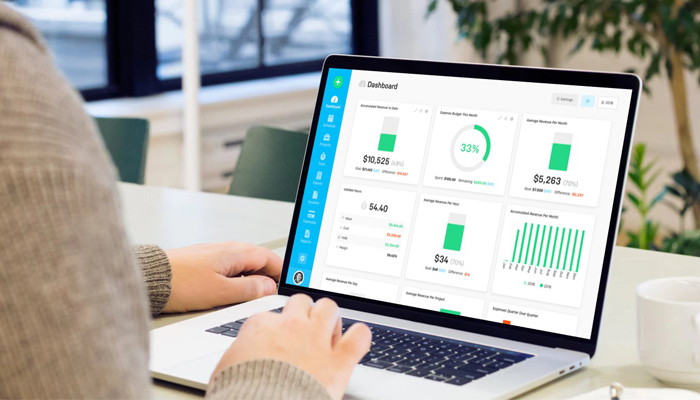
Short Summary: When Harpoon 3 launches you might notice your account’s expected revenue and project profitability calculations are different from what they were in Harpoon 2. This is by design. If you’re interested in understanding the details then read on. Thanks!
As we’re tying up loose ends for the upcoming Harpoon 3 launch we wanted to take a moment and prepare you for some of the changes you can expect with this new version of the product.
Specifically in this post we’ll be focusing on changes in the way Harpoon 3 calculates some of your financial metrics. When Harpoon 3 launches you’ll notice your metrics will be different in two key areas: expected revenue and project profitability.
Expected Revenue
One of the key benefits of using Harpoon is the ability to forecast your business’s expected revenue. This enables you to look ahead into the future and see how the expected revenue from your client projects will affect your business’s monthly and yearly revenue goals. It’s an extremely powerful way to plan your client projects and provides peace of mind being able to see where your business stands financially months ahead of time.
In Harpoon 3 we’re taking expected revenue to the next level by introducing advanced automation to track new sources of expected revenue:
Unpaid Invoices: Just like in Harpoon 2 all of your unpaid invoices will continue to be tracked as expected revenue in Harpoon 3. When you create invoices in Harpoon the outstanding balances of each invoice will be calculated as expected revenue for your business with those amounts displayed on your Schedule based on the date of each invoice. As an invoice becomes paid Harpoon will automatically convert those amounts from expected to collected revenue in your account.
Future Recurring Invoices: This is another source of expected revenue that we’re carrying over from Harpoon 2. When you create a recurring invoice template Harpoon will automatically track the future amounts of those invoices and display those amounts as expected revenue on your Schedule based on the dates each future invoice is scheduled to be generated. This turns recurring invoices into a powerful forecasting tool, especially handy for projects like ongoing retainers or other recurring services you provide your clients.
Unbilled Hours: This is a new source of expected revenue that we’re introducing in Harpoon 3. Every time-tracking entry your team records in Harpoon 3 will have a unique value associated with it. This value is based on custom hourly rates that you’ll have complete control over, whether on a global, client, or project level. This means Harpoon 3 has the ability to calculate how much expected revenue you can plan to receive from all of the unbilled hours across all projects in your account even before you’ve had a chance to actually invoice for those hours. Every day your business’s expected revenue will be auto-adjusted based on the work your team performed that very day. And when you do get around to billing for those hours Harpoon is smart enough to automatically track those hours to your invoices so that the hours aren’t counted twice as expected revenue in your account. It works like magic. “But Andy, what if I’m recording hours for a project that I don’t plan on billing for?” No problem. In Harpoon 3 hours (and projects for that matter) can be assigned a new “Non-Billable” status. This status keeps Harpoon from tracking those hours as expected revenue. We’ll share more about that at launch.
Fixed Fee Project Budgets: This is another new source of expected revenue we’ve added to Harpoon 3. In the new version of Harpoon you’ll be able to assign a unique project “type” to each of your projects (i.e. Hourly, Fixed Fee, or Non-Billable). When creating a Fixed Fee project you’ll enter the fixed amount you plan to bill for the project. This becomes the project’s Fixed Fee Budget. Harpoon uses this Fixed Fee Budget as a source of expected revenue and displays it on your Schedule. And Harpoon is smart enough to properly balance a project’s Fixed Fee Budget with any invoices that are being created for the project so that your expected revenue for the project isn’t artificially inflated. In other words this gives you the benefit of including a project’s fixed fee amount in your expected revenue calculations before you’ve even created an invoice for the project; and as you do create invoices Harpoon will automatically keep the project’s expected revenue amount balanced and accurate. We’ll share more about Fixed Fee projects when Harpoon 3 launches.
Adding Expected Revenue Manually: We’ll be carrying over this feature from Harpoon 2. This allows you to manually enter sources of expected revenue that are outside of the sources Harpoon automatically tracks (i.e. unpaid invoices, future recurring invoices, unbilled hours, and fixed fee budgets). Given the improved automation and new sources of expected revenue being added to Harpoon 3 we predict this manual method will be used far less than it was before. But it's still there if you need it.
Expected Revenue Rollover: In Harpoon 2 whatever month an expected revenue amount originally appeared on your Schedule is the month it remains in. In other words if you had expected revenue from an unpaid invoice show up on your Schedule in January then that amount remains in January even if January is now in the past. This has meant in Harpoon 2 you probably have expected revenue scattered all throughout past months of the calendar. This approach has its use cases. But over time we’ve become convinced that those use cases are outweighed by the inconvenience of trying to determine how expected revenue from the past affects your current and future revenue goals. So in Harpoon 3 we’ve added a new expected revenue rollover behavior. This means Harpoon will continuously “roll over” any expected revenue from each past month into each new month as time progresses throughout the year. This will likely change your expected revenue metrics for the current month when Harpoon 3 launches.
All of the above changes combined will make Harpoon 3 by far the most powerful financial forecasting and goal-tracking tool on the market today for agencies, studios, and professional freelancers. And we don’t think that statement is an exaggeration in the least.
Project Profitability
The other financial metric where you’ll notice changes in Harpoon 3 is with your projects’ profit and loss calculations.
In Harpoon 2 a project’s profit and loss was calculated by taking the project's total collected revenue and subtracting the total amount of expenses recorded for the project. This worked fine as long as your labor costs happened to be included in the project’s list of recorded expenses. But that’s at best an inconvenient method of tracking labor costs especially when expense records for employees and contractors typically span across multiple projects.
In Harpoon 3 a project’s labor costs will be automatically tracked and included in the project’s overall “cost” making the profit and loss calculation for the project more complete and accurate. Harpoon 3 accomplishes this by providing a new “internal cost rate” for each of your team members. This rate is the internal hourly cost your business incurs for the work performed by each team member. This cost can of course be customized on a per team member basis, and even further on a per project basis.
Now every hour recorded by a team member in Harpoon 3 will not only have a value associated with it (the amount you could bill your client for that hour), but also a cost associated with it (the amount the team member’s work cost your business). The end result is a project profit and loss calculation that takes into account both labor and non-labor expenses, without you needing to manually figure out the labor side of the equation.
What’s Next?
I know those are a lot of details to digest, but we didn’t want you to be confused with these updated calculations when Harpoon 3 launches. The good news is you don’t really need to be too concerned with how it all works. All you need to focus on is billing your clients. Harpoon does all the rest behind the scenes. This means more financial intelligence for you with less work required.
At this point it's likely our next news about Harpoon 3 will be the launch announcement itself! A little “insider" information is that we’re planning to launch Harpoon 3 in multiple phases (i.e. v3.0, v3.1, and v3.2). We decided to do this in order to speed up the initial v3.0 launch which will include the new design along with a ton of new features that are ready for public release. We’ll then follow up with releasing v3.1 and v3.2 which contain their own big features, but at this point still have a few bugs to squash.
To our current customers, we appreciate your enthusiasm, patience, and support as we’ve been working so hard these last few months to deliver Harpoon 3. Our team is already in love with v3 and we can’t wait for you to have it in your hands. We’ll talk more soon!







